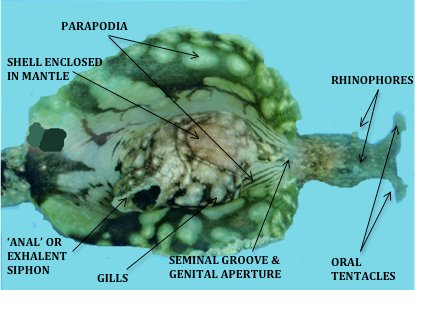Physical Description
Aplysia are one of the few molluscs that are characterized, not by the presence, but rather by the absence of an external shell (Rupert, Fox & Barnes 2004). Although not completely absent, the vestigial shell, which is thought to function as protection for the animal's heart and gonads, is embedded within the mantle cavity and so is not easily apparent on first inspection (Beesley, Ross & Wells 1998). The rest of the body has a soft, sometimes leathery slug-like appearance. Colours vary markedly, both between different species and between individuals of the same species as a result of variations in diet (Marshall & Willan 1999). This is because the different species of algae that Aplysia feed on impart unique chemicals that alter the animals colouration (and may be involved in chemical defense) (Appelton, Babcock & Copp 2001). In the Great Barrier Reef, A. dactylomela are generally light green to brown in colouration and has characteristic patchy, incomplete black circles that cover their whole body (Appleton, Babcock & Copp 2001).

Diagramatic dorsal view of A. dactylomela, with focus on key diagnostic features.
The oral tentacles, rhinophores and parapodia are all lateral extensions of the mantle tissue (Beesley, Ross & Wells 1998). While the oral tentacles are thought to be used as “touch sensors”, the rhinophores are believed to perform a more chemosensory role (Beesley, Ross and Wells 1998). As a simultaneous hermaphrodite, A. dactylomela utilize their seminal grooves and genital apertures to enable the formation of “mating chains” (Lederhender & Tobach 1977). With the exception of the first and last animal in the chain, each participant acts as both a sperm recipient and a sperm donor (Lederhender & Tobach 1977). |